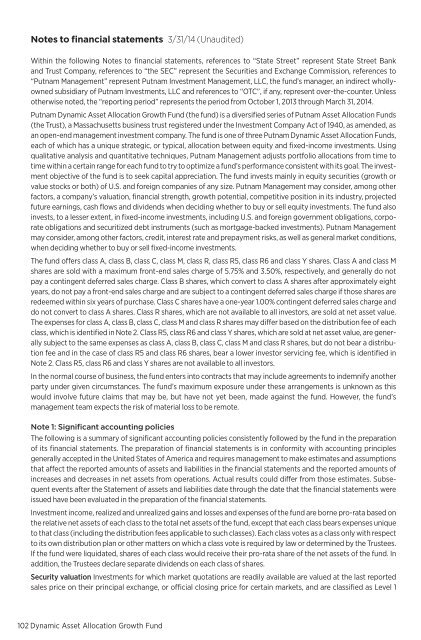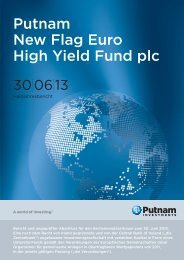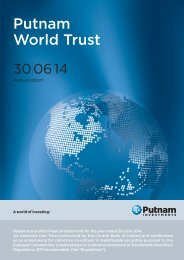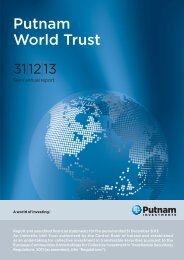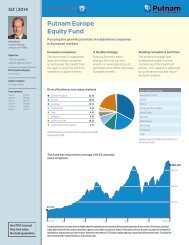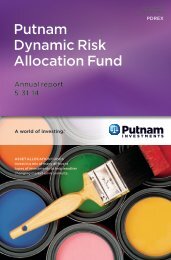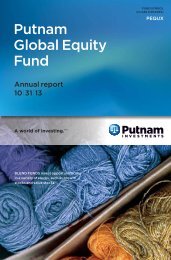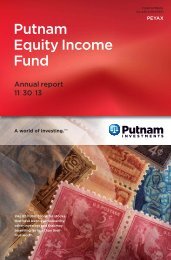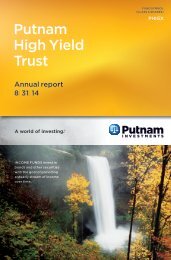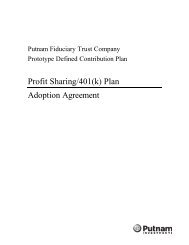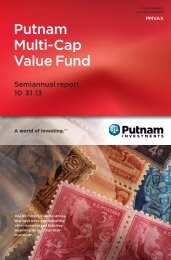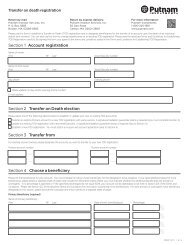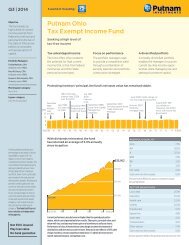March - Putnam Investments
March - Putnam Investments
March - Putnam Investments
- No tags were found...
Create successful ePaper yourself
Turn your PDF publications into a flip-book with our unique Google optimized e-Paper software.
Notes to financial statements 3/31/14 (Unaudited)Within the following Notes to financial statements, references to “State Street” represent State Street Bankand Trust Company, references to “the SEC” represent the Securities and Exchange Commission, references to“<strong>Putnam</strong> Management” represent <strong>Putnam</strong> Investment Management, LLC, the fund’s manager, an indirect whollyownedsubsidiary of <strong>Putnam</strong> <strong>Investments</strong>, LLC and references to “OTC”, if any, represent over-the-counter. Unlessotherwise noted, the “reporting period” represents the period from October 1, 2013 through <strong>March</strong> 31, 2014.<strong>Putnam</strong> Dynamic Asset Allocation Growth Fund (the fund) is a diversified series of <strong>Putnam</strong> Asset Allocation Funds(the Trust), a Massachusetts business trust registered under the Investment Company Act of 1940, as amended, asan open-end management investment company. The fund is one of three <strong>Putnam</strong> Dynamic Asset Allocation Funds,each of which has a unique strategic, or typical, allocation between equity and fixed-income investments. Usingqualitative analysis and quantitative techniques, <strong>Putnam</strong> Management adjusts portfolio allocations from time totime within a certain range for each fund to try to optimize a fund’s performance consistent with its goal. The investmentobjective of the fund is to seek capital appreciation. The fund invests mainly in equity securities (growth orvalue stocks or both) of U.S. and foreign companies of any size. <strong>Putnam</strong> Management may consider, among otherfactors, a company’s valuation, financial strength, growth potential, competitive position in its industry, projectedfuture earnings, cash flows and dividends when deciding whether to buy or sell equity investments. The fund alsoinvests, to a lesser extent, in fixed-income investments, including U.S. and foreign government obligations, corporateobligations and securitized debt instruments (such as mortgage-backed investments). <strong>Putnam</strong> Managementmay consider, among other factors, credit, interest rate and prepayment risks, as well as general market conditions,when deciding whether to buy or sell fixed-income investments.The fund offers class A, class B, class C, class M, class R, class R5, class R6 and class Y shares. Class A and class Mshares are sold with a maximum front-end sales charge of 5.75% and 3.50%, respectively, and generally do notpay a contingent deferred sales charge. Class B shares, which convert to class A shares after approximately eightyears, do not pay a front-end sales charge and are subject to a contingent deferred sales charge if those shares areredeemed within six years of purchase. Class C shares have a one-year 1.00% contingent deferred sales charge anddo not convert to class A shares. Class R shares, which are not available to all investors, are sold at net asset value.The expenses for class A, class B, class C, class M and class R shares may differ based on the distribution fee of eachclass, which is identified in Note 2. Class R5, class R6 and class Y shares, which are sold at net asset value, are generallysubject to the same expenses as class A, class B, class C, class M and class R shares, but do not bear a distributionfee and in the case of class R5 and class R6 shares, bear a lower investor servicing fee, which is identified inNote 2. Class R5, class R6 and class Y shares are not available to all investors.In the normal course of business, the fund enters into contracts that may include agreements to indemnify anotherparty under given circumstances. The fund’s maximum exposure under these arrangements is unknown as thiswould involve future claims that may be, but have not yet been, made against the fund. However, the fund’smanagement team expects the risk of material loss to be remote.Note 1: Significant accounting policiesThe following is a summary of significant accounting policies consistently followed by the fund in the preparationof its financial statements. The preparation of financial statements is in conformity with accounting principlesgenerally accepted in the United States of America and requires management to make estimates and assumptionsthat affect the reported amounts of assets and liabilities in the financial statements and the reported amounts ofincreases and decreases in net assets from operations. Actual results could differ from those estimates. Subsequentevents after the Statement of assets and liabilities date through the date that the financial statements wereissued have been evaluated in the preparation of the financial statements.Investment income, realized and unrealized gains and losses and expenses of the fund are borne pro-rata based onthe relative net assets of each class to the total net assets of the fund, except that each class bears expenses uniqueto that class (including the distribution fees applicable to such classes). Each class votes as a class only with respectto its own distribution plan or other matters on which a class vote is required by law or determined by the Trustees.If the fund were liquidated, shares of each class would receive their pro-rata share of the net assets of the fund. Inaddition, the Trustees declare separate dividends on each class of shares.Security valuation <strong>Investments</strong> for which market quotations are readily available are valued at the last reportedsales price on their principal exchange, or official closing price for certain markets, and are classified as Level 1102 Dynamic Asset Allocation Growth Fund


